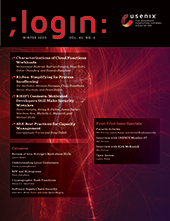
SRE Best Practices for Capacity Management
;login: Enters a New Phase of Its Evolution
For over 20 years, ;login: has been a print magazine with a digital version; in the two decades previous, it was USENIX’s newsletter, UNIX News. Since its inception 45 years ago, it has served as a medium through which the USENIX community learns about useful tools, research, and events from one another. Beginning in 2021, ;login: will no longer be the formally published print magazine as we’ve known it most recently, but rather reimagined as a digital publication with increased opportunities for interactivity among authors and readers.
Since USENIX became an open access publisher of papers in 2008, ;login: has remained our only content behind a membership paywall. In keeping with our commitment to open access, all ;login: content will be open to everyone when we make this change. However, only USENIX members at the sustainer level or higher, as well as student members, will have exclusive access to the interactivity options. Rik Farrow, the current editor of the magazine, will continue to provide leadership for the overall content offered in ;login:, which will be released via our website on a regular basis throughout the year.
As we plan to launch this new format, we are forming an editorial committee of volunteers from throughout the USENIX community to curate content, meaning that this will be a formally peer-reviewed publication. This new model will increase opportunities for the community to contribute to ;login: and engage with its content. In addition to written articles, we are open to other ideas of what you might want to experience.

As an SRE, you're responsible for determining the initial resource requirements of your service and ensuring your service behaves reasonably even in the face of unexpected demand. Capacity management is the process of ensuring you have the appropriate amount of resources for your service to be scalable, efficient, and reliable. User-facing and company internal services must accommodate both expected and unexpected growth. We define utilization as the percentage of a resource that is being used. It's difficult to determine initial resource utilization and predict future needs. We present ways to estimate utilization and identify blind spots, and we discuss the benefits of building in redundancy to avoid failures. You'll use this information to design your architecture such that increasing the resource allocation for each component of the service effectively increases the capacity of the entire service linearly.
